Dear Pre-VGRD,
Thank you for allowing me to present this difficult case.
The patient is a 60-year-old journalist, who presents for evaluation of genital pain that has been present for about six months. He has been in his usual state of health. No new sports or traumas. His medications include atorvastin, buproprion and the generic omeprazole.
He has an annoying, painful sensation on the ventral shaft of the penis. He has noted some hyperpigmentation there and occasionally the skin here gets red. He thinks this lasts for a few hours but he is not sure. The sensation is like that of an abrasion. He saw a urologist who prescribed clobetasol cream but did not note anything in the area. He used the clobetasol for a few weeks but found that it only seemed to make the pain worse.
EXAMINATION: The examination shows a healthy, appearing 60-year-old man who is a good historian. He has a dark line on the ventral surface of the shaft of the penis. The skin here is completely normal. There was no evidence of erythema today.
IMPRESSION: This is a genital pain syndrome. It may be related to what is called scrotodynia. I also seem to remember some cases that were reported in which there was dermographic urticaria on the genitalia. I could not find references to those. The best that I can come up with at this point is a local genital pain syndrome similar to scrotodynia or vulvodynia. These are poorly understood and the treatments are not particularly effective. If this were genital dermographic urticaria, probably an antihistamine such as hydroxyzine would work.
Those of us who are dermatologists see such cases occasionally. I would appreciate your thoughts.
Marius Grenoble, QUÉBEC CITY, QC, Canada
This is a rapid publication site that replaces Virtual Grand Rounds in Dermatology (vgrd.org). Please join and feel free to post cases. You can share the URL with friends. Since 2000, VGRD has been a valuable means to share cases in real time from one's home or office. "AND GLADLY WOLDE HE LERNE AND GLADLY TECHE" has served as an enduring and inspirational motto. For more information, see the "About Page."
Wednesday, May 24, 2006
Thursday, May 18, 2006
Photosensitive dermatitis from bleaching creams

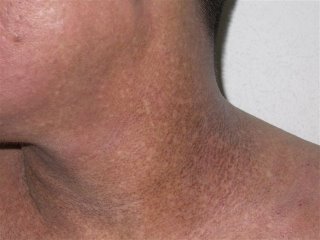


My friend, David Elpern MD, a dermatologist from Williamstown, USA sent this note to me.
"NY Times
May 14, 2006
A Vision of Pale Beauty Carries Risks for Asia's Women
By THOMAS FULLER
MAKHAM KHU, Thailand - Neighbors gawk and children yell, "Ghost!" The manager of the restaurant where Panya Boonchun worked simply told her she was fired.
The cream that she applied to her face and neck was supposed to transform her into a white-skinned beauty, the kind she saw in women's magazines and on television.
But the illegally produced lotion she bought in a store near this village in southeastern Thailand turned her skin into a patchwork of albino pink and dark brown. Doctors say her condition may be irreversible.
"I never look in the mirror anymore," she said, sobbing during an interview.
Whiter skin is being aggressively marketed across Asia, with vast selections of skin-whitening creams on supermarket and pharmacy shelves testament to an industry that has flourished over the past decade. In Hong Kong, Malaysia, the Philippines, South Korea and Taiwan, 4 of every 10 women use a whitening cream, a survey by Synovate, a market research company, found."
And it so happened the same morning I saw a 33-year-old man who had been applying a bleaching cream from Southern Thailand for his melasma. After several weeks of application, He noticed pigmentary changes on his face which was dusky brownish tinge on the forehead, cheeks and chin. It has now spread to the neck as well. Past one week, he noticed skin eruptions appearing on the forearms as well. He was otherwise well and has no fever or polyarthralgia.
His medication history included OTC garlic pills and fish oil. He is however a heavy drinker.
Examination of the skin showed diffuse dusky erythematous to brownish macules on the patient's ears, face and neck. The eruptions somehow spares the nose. Eczematous eruptions were noted on the forearms bilaterally. There were no hepatosplenomegaly. There were no sclerodactyly changes on the fingers.
My first impression was could this be the "southern thailand bleaching creams ghostly onchronosis due to high concentration hydroquinone cream??
Investigations done showed normal blood counts and blood biochemistry. ANA serology was negative.
I suspect this is some form of photosensitive dermatitis. Porphyria cutanea tarda runs thro my mind as a differential as he is heavy drinker but his LFTs were normal. I have never seen this before.
Wednesday, May 17, 2006
Onycholysis
The patient is a healthy 58 year old woman with a 3 year history of onycholysis. Fungal culture has grown out Candida zeylanoides. Bacterial culture negative.
Topicals have not been of help. (imidazoles and thymol in chloroform)
Would fluconazole be of value?
Should the nail be avulsed?
Who has had success treating this kind of problem?

Topicals have not been of help. (imidazoles and thymol in chloroform)
Would fluconazole be of value?
Should the nail be avulsed?
Who has had success treating this kind of problem?

Thursday, May 11, 2006
Pellagra in Alcoholics
In Iraq, pellagra is only seen in sporadic cases in patients with alcoholism. I describe here a case of pellagra in 30 year old man who used to drink alcohol one litre a day of a local beverage called ARAK. In addition, his nutrition was poor. He developed a typical rash of pellagra in photosensitive area, some lesions are bullous together with beefy tongue. The rash resolved quickly after vitamin replacement but recurred when he resumed alcohol drinking.
I would like to ask my colleagues
1) how often see pellagra
2) what is the cause?
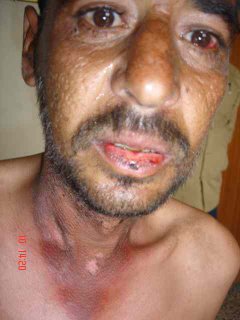

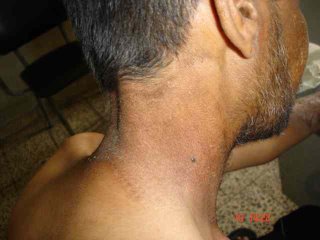
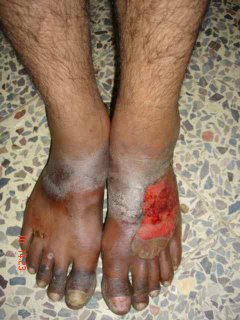

I would like to ask my colleagues
1) how often see pellagra
2) what is the cause?





Tuesday, May 09, 2006
Nail Bed Carcinoma
The patient is s 70 yo man who was seen today for a three year follow-up of micrographic surgery for a sqaumous cell carcinoma of the nail bed. There is no evidence of recurrence and the results are cosmetically excellent.
I had another patient with a similar lesion. He was a VA patient and they did not approve him for microgrpahic surgery. He had the distal part of his thumb excised. Bizarre that health insurance trumps the interests of the patient.
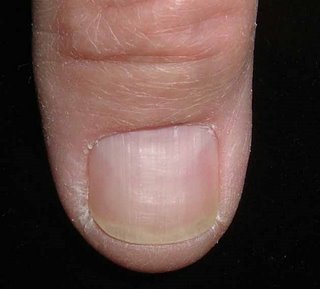
I had another patient with a similar lesion. He was a VA patient and they did not approve him for microgrpahic surgery. He had the distal part of his thumb excised. Bizarre that health insurance trumps the interests of the patient.

Friday, May 05, 2006
Folliculitis and Hair Loss
The patient is a 30 year-old man with a 2 year history of folliculitis and mild hair loss. He has erythematous papules and a few pustules scattered over the scalp. Cultures have been negative. Biopsy showed only inflammation c/w folloculitis. Minocycline has been of marginal help, but process recurrs when he stops. He has an occasional papule on his cheeks but no signs of rosacea. His hair is globally thin.
Question: Is this folliculitis decalvans? Would isotretinoin be worth trying? He is also interested in hair transplantation.
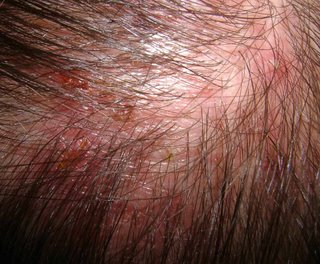
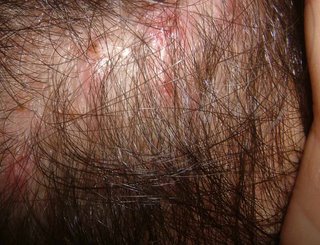
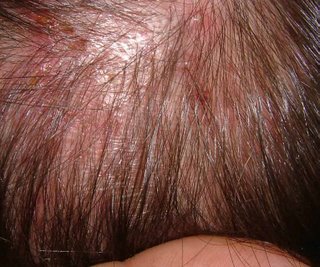
Question: Is this folliculitis decalvans? Would isotretinoin be worth trying? He is also interested in hair transplantation.


